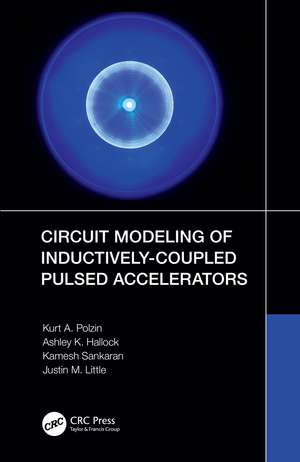Circuit Modeling of Inductively-Coupled Pulsed Accelerators
Autor Kurt A. Polzin, Ashley K. Hallock, Kamesh Sankaran, Justin M. Littleen Limba Engleză Hardback – 18 noi 2022
This monograph is of interest to researchers and graduate students in physics, engineering, and mathematics presently studying inductively-coupled pulsed accelerators.
Features
- The first book to unify the lumped-element modelling techniques for various inductively-coupled pulsed accelerator implementations.
- Discussion of modelling different accelerators in a coherent, rigorous manner, demonstrating the similarities and differences for each type.
- Authored by authorities in the field.
| Toate formatele și edițiile | Preț | Express |
|---|---|---|
| Paperback (1) | 306.94 lei 6-8 săpt. | |
| CRC Press – 9 oct 2024 | 306.94 lei 6-8 săpt. | |
| Hardback (1) | 639.01 lei 3-5 săpt. | +17.02 lei 6-12 zile |
| CRC Press – 18 noi 2022 | 639.01 lei 3-5 săpt. | +17.02 lei 6-12 zile |
Preț: 639.01 lei
Preț vechi: 702.21 lei
-9% Nou
Puncte Express: 959
Preț estimativ în valută:
122.28€ • 127.83$ • 103.33£
122.28€ • 127.83$ • 103.33£
Carte disponibilă
Livrare economică 14-28 februarie
Livrare express 30 ianuarie-05 februarie pentru 27.01 lei
Preluare comenzi: 021 569.72.76
Specificații
ISBN-13: 9780367349004
ISBN-10: 0367349000
Pagini: 104
Ilustrații: 2 Tables, black and white; 20 Line drawings, black and white; 20 Illustrations, black and white
Dimensiuni: 138 x 216 x 12 mm
Greutate: 0.35 kg
Ediția:1
Editura: CRC Press
Colecția CRC Press
ISBN-10: 0367349000
Pagini: 104
Ilustrații: 2 Tables, black and white; 20 Line drawings, black and white; 20 Illustrations, black and white
Dimensiuni: 138 x 216 x 12 mm
Greutate: 0.35 kg
Ediția:1
Editura: CRC Press
Colecția CRC Press
Cuprins
1. Introduction 2. Fundamental Concepts for Inductively-Coupled Pulsed Acceleration 3. Electrical Circuits 4. Equations of Motion 5. Internal Models 6. Illustrative Results 7. Concluding Remarks. Bibliography. Index.
Notă biografică
Kurt A. Polzin is Chief Engineer for Space Nuclear Propulsion at NASA's Marshall Space Flight Center. He received his Ph.D. in Mechanical and Aerospace Engineering from Princeton University in 2006. Dr. Polzin specializes in electric thrusters and space nuclear power and propulsion systems. He is a Senior Member of the Institute for Electrical and Electronics Engineers (IEEE) and an Associate Fellow of the American Institute of Aeronautics and Astronautics (AIAA).
Ashley K. Hallock is the Electric Propulsion Subsystems Lead Engineer at OHB Sweden, working with teams to develop electric and chemical propulsion subsystems for a wide range of satellites. She received her Ph.D. in Mechanical and Aerospace Engineering from Princeton University in 2012. Dr. Hallock is a Senior Member of the American Institute of Aeronautics and Astronautics (AIAA) and serves on the Nuclear & Future Flight Propulsion and Plasmadynamics & Lasers Technical Committees.
Kamesh Sankaran is a Professor of Engineering & Physics at Whitworth University. He received his Ph.D. in Mechanical and Aerospace Engineering from Princeton University in 2005. Prof. Sankaran has been on the faculty at Whitworth since 2004, where he specializes in spacecraft propulsion, plasma physics, computational physics, shock physics, and public policy in science and technology. He is a Senior Member of the American Institute of Aeronautics and Astronautics (AIAA).
Justin M. Little is an Assistant Professor of Aeronautics & Astronautics at the University of Washington. He received his Ph.D. in Mechanical and Aerospace Engineering from Princeton University in 2014. His research interests focus on novel electric propulsion concepts with applications to space exploration, telecommunications, and low-cost small satellites. Prof. Little is a recipient of an AFOSR Young Investigator Award and serves on the American Institute of Aeronautics and Astronautics (AIAA) Electric Propulsion Technical Committee.
Ashley K. Hallock is the Electric Propulsion Subsystems Lead Engineer at OHB Sweden, working with teams to develop electric and chemical propulsion subsystems for a wide range of satellites. She received her Ph.D. in Mechanical and Aerospace Engineering from Princeton University in 2012. Dr. Hallock is a Senior Member of the American Institute of Aeronautics and Astronautics (AIAA) and serves on the Nuclear & Future Flight Propulsion and Plasmadynamics & Lasers Technical Committees.
Kamesh Sankaran is a Professor of Engineering & Physics at Whitworth University. He received his Ph.D. in Mechanical and Aerospace Engineering from Princeton University in 2005. Prof. Sankaran has been on the faculty at Whitworth since 2004, where he specializes in spacecraft propulsion, plasma physics, computational physics, shock physics, and public policy in science and technology. He is a Senior Member of the American Institute of Aeronautics and Astronautics (AIAA).
Justin M. Little is an Assistant Professor of Aeronautics & Astronautics at the University of Washington. He received his Ph.D. in Mechanical and Aerospace Engineering from Princeton University in 2014. His research interests focus on novel electric propulsion concepts with applications to space exploration, telecommunications, and low-cost small satellites. Prof. Little is a recipient of an AFOSR Young Investigator Award and serves on the American Institute of Aeronautics and Astronautics (AIAA) Electric Propulsion Technical Committee.
Descriere
This monograph is of interest to researchers and graduate students in physics, engineering, and mathematics presently studying inductively-coupled pulsed accelerators.
